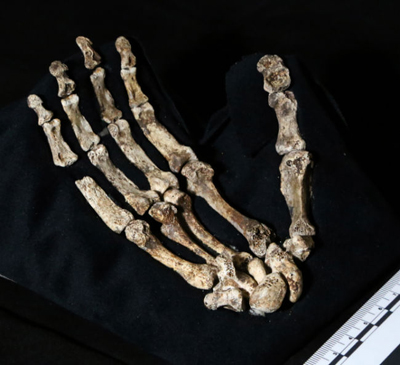
An exciting new hominid fossil has been found in the deepest recesses of the Rising Star Cave, about 20 miles Northwest of Johannesburg, South Africa.
The fossil remains include nearly complete skeletons of several individuals, and remains of at least 15 separate individuals, which is unusual because the more usual discovery is of isolated broken up crania only, with occasional other bits and pieces. Though the find will not revolutionize science’s ideas of how our species evolved, it gives a more complete picture of the basic pattern and raises interesting questions about the cognitive abilities of these possible ancestors of modern human beings.
The findings from the initial 2013 discovery and subsequent research were just announced by Dr. Lee Berger, Research Professor at the Evolutionary Studies Institute and the Center of Excellence in Paleoscience at Witwatersrand University in Johannesburg. Berger has had a distinguished career in physical anthropology and human paleontology, having discovered, among other things, a new species of Australopithecine, Australopithecus sediba, in another South African cave in 2008.
The remains were found in a very deep recesses of Rising Star Cave, so far in that Berger had to employ especially thin people to reach them. The positioning of the skeletons suggests that they may have been put there deliberately, but gives no clue as to why, when or by whom. The remains, with their advanced degree of fossilization, probably will not lend themselves to carbon 14 dating, so it might be a while before we know what approximate dates to assign to them.
The remains themselves show a mixture of very ancient and more modern features. The hands appear to be adapted for using tools, but the fingers also show curvature that suggests that they were capable tree-climbers. The feet are very similar to those of modern human beings rather than apes. The teeth include molars with smaller, human-like front teeth. The skulls look very much like those of the well-known Homo erectus, which lived in this part of Africa and also in Europe and Asia between 1.9 million and 200,000 years before the present. African variants of early Homo are sometimes called Homo ergaster, but many scientists now think that this is just a sub variety of Homo erectus.
However, the cranial capacity, meaning brain size, of the individuals is considerably smaller than the average for other Homo erectus populations. This and other factors led Lee and his team to propose that this is actually a different Homo species, which they are calling Homo naledi. But this set off a controversy. In recent years, some scientists have been complaining that the way fossil hominid remains have been classified and named underplays the degree of anatomical variety found in any one species. So the designation of the skeletons as Homo naledi and not just as a subgroup of the old familiar Homo erectus, is being met with some skepticism. Unfortunately, with remains that have reached an advanced state of fossilization, it is impossible to do DNA analysis which might resolve this question. However, Berger’s team will try.
Some reports express surprise at the placing of the remains in the furthest recesses of the cave. It looks deliberate, but did small brained beings like these have the capacity to carry out deliberate burials with some sort of symbolic meaning?
Well, why not? Even the species generally acknowledged to have preceded Homo erectus, the smaller-brained Homo habilis, is known to have made and used simple tools, and others of the Homo erectus/Homo ergaster complex made more sophisticated ones. Also, there are indications that the erectus/ergaster knew the use of fire and may even have had the beginnings of speech and language capacity. So it seems no big to stretch to think that they may have had some deliberate way of disposing of their dead. Yet the idea has been suggested that the skeletons were those of individuals killed by more modern human types who then stashed the bodies in the cave. To me, this seems very speculative.
Anyway, the find is stunning because of the number of individuals and the completeness of their remains. It does not radically change the overall understanding of how and where human beings evolved: This probable progression still holds: A split from the line that evolved into chimpanzees and bonobos perhaps ten million years ago, Sahelanthropus in what is now Chad dated at about 7 million years ago; then varieties of the genus Ardepithecus in East Africa about 4 ½ million years ago, and Australopithecus (several species) in East and Southern Africa about four million years ago. The first member of the genus Homo, Homo habilis, our first known tool making ancestor, appears on the scene in Eastern and Southern Africa perhaps 2.8 to 1.5 million years ago, followed by the Homo erectus/Homo ergaster complex. Anatomically modern human beings appeared in East Africa around 200,000 years ago. Both erectus/ergaster and modern Homo sapiens had African origins from which they spread to Asia and Europe, and then Homo sapiens all over the globe.
The overall pattern since the split from the ancestors of chimpanzees and bonobos has involved the development of erect bipedal posture, tool making, beginnings of language and increased cranial capacity. In all likelihood, increased sociality-the ability to function as an organized social group-developed along with all this, and the full development of modern brain capacity followed behind the rest, as postulated long ago by Friedrich Engels, Marx’s collaborator.
So the development of human sociality was the force driving the development of the modern human being, anatomically, cognitively and emotionally.
Or to quote a familiar Zulu saying from another area of South Africa: “Umuntu ngumuntu ngabantu”. “A person becomes a person through (other) people”. This originally referred to how we are socialized, but turns out to be applicable to how we evolved as well.
Photo: Homo naledi hand. cc John Hawks_Wits University, University of Witwatersrand homo naledi image gallery.









Comments